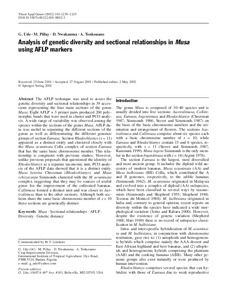| dc.contributor.author | Ude, G. |
| dc.contributor.author | Pillay, M. |
| dc.contributor.author | Nwakanma, D. |
| dc.contributor.author | Tenkouano, A. |
| dc.date.accessioned | 2019-12-04T11:21:33Z |
| dc.date.available | 2019-12-04T11:21:33Z |
| dc.date.issued | 2002 |
| dc.identifier.citation | Ude, G., Pillay, M., Nwakanma, D. & Tenkouano, A. (2002). Analysis of genetic diversity and sectional relationships in Musa using AFLP markers. Theoretical and Applied Genetics, 104(8), 1239-1245. |
| dc.identifier.issn | 0040-5752 |
| dc.identifier.uri | https://hdl.handle.net/20.500.12478/3817 |
| dc.description.abstract | The AFLP technique was used to assess the genetic diversity and sectional relationships in 39 accessions representing the four main sections of the genus Musa. Eight AFLP + 3 primer pairs produced 260 poly-morphic bands that were used in cluster and PCO analysis. A wide range of variability was observed among the species within the sections of the genus Musa. AFLP da-ta was useful in separating the different sections of the genus as well as differentiating the different genomic groups of section Eumusa. Section Rhodochlamys (x= 11) appeared as a distinct entity and clustered closely with the Musa acuminataColla complex of section Eumusa that has the same basic chromosome number. This rela-tionship is congruent with previous studies. However, unlike previous proposals that questioned the identity of Rhodochlamysas a separate taxonomic unit, PCO analysis of the AFLP data showed that it is a distinct entity. Musa laterita Cheesman (Rhodochlamys) and MusaschizocarpaSimmonds clustered with the M. acuminata complex suggesting that they may be sources of useful genes for the improvement of the cultivated bananas. Callimusa formed a distinct unit and was closer to Australimusa than to the other sections. Although both sections share the same basic chromosome number of x= 10these sections are genetically distinct. |
| dc.description.sponsorship | Directorate-General for Development Cooperation and Humanitarian Aid, Belgium |
| dc.language.iso | en |
| dc.subject | Musa |
| dc.subject | Sectional Relationships |
| dc.subject | Aflp |
| dc.subject | Diversity |
| dc.subject | Genetic Distance |
| dc.subject | Rhodochlamys |
| dc.subject | Bananas |
| dc.title | Analysis of genetic diversity and sectional relationships in Musa using AFLP markers |
| dc.type | Journal Article |
| dc.description.version | Peer Review |
| cg.contributor.affiliation | International Institute of Tropical Agriculture |
| cg.coverage.region | Africa |
| cg.coverage.region | West Africa |
| cg.coverage.country | Nigeria |
| cg.isijournal | ISI Journal |
| cg.authorship.types | CGIAR single centre |
| cg.iitasubject | Genetic Improvement |
| cg.iitasubject | Plantain |
| cg.iitasubject | Banana |
| cg.iitasubject | Plant Genetic Resources |
| cg.accessibilitystatus | Limited Access |
| local.dspaceid | 95972 |
| cg.identifier.doi | https://doi.org/10.1007/s00122-001-0802-3 |

